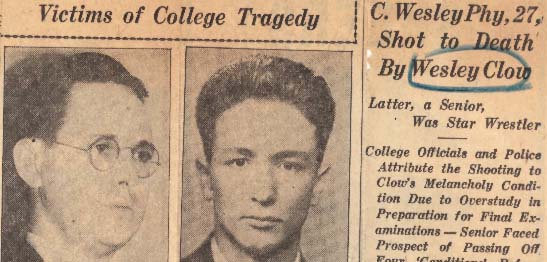Almost 88 years ago, Lehigh University was the site of a murder-suicide.
On June 4, 1936, 23-year-old Wesley Clow fatally shot Lehigh professor C. Wesley Phy, after Phy told Clow he would need the dean’s permission to retake an exam that day for which the student was more than 90 minutes late.
Clow was only months away from graduating when he pulled out a revolver and fatally shot the professor. He then turned the gun to himself and pulled the trigger.
Both the professor and the student passed away at the hospital.
Phy joined Lehigh University in 1931 as an instructor and had been studying for his Ph.D. degree at the time of his death.
Clow, a Lehigh athlete, was a member of the wrestling team.
Although school shootings were rare at the time, this tragedy offered insights into the evolution of campus safety policies and the understanding of violence in educational institutions.
The Violence Project, co-founded by Dr. Jillian Peterson and Dr. James Densley, is dedicated to reducing violence through research. They’re most well-known for their mass shooter database.
According to The Violence Project Database, it wasn’t until 1966 that mass shootings on or near college campuses began increasing. In the 1930s there were only seven school shootings across the United States compared to the 2010s, where 264 were reported.
Lehigh Police Chief Jason Schiffer is the assistant vice president of campus safety. He said a large part of being proactive and avoiding such tragedies is education.
“In today’s context, we have a team of people on campus that are dedicated to trying to detect and provide support and resources for anybody that might be dealing with some sort of crisis in their lives,” Schiffer said.
Before support resources were implemented at Lehigh, Schiffer noticed universities were taking a more holistic approach to safety.
“It’s not just a police matter, like safety on campus,” Schiffer said. “There were some concerns that there were gaps within the individual departments. Looking back we didn’t have a holistic approach to safety across campus.”
As a solution, Lehigh adopted the Care Team.
The Care Team at Lehigh serves as “an interdisciplinary group of campus professionals who monitor and provide early intervention to students whose behavior or circumstances are concerning or disruptive,” according to the Student Affairs website.
Schiffer said the Care Team’s initiative at Lehigh was established in response to the Virginia Tech shooting in 2007. It represents an immediate concern to a broader culture of care and vigilance within the academic community.
Dr. Peter Langman is a psychologist and director of research and school safety training at Drift Net Securities, a Chicago-based organization committed to campus security. He has published numerous articles and books on school shootings and school safety.
Langman has delved into the psychological aspects of school shootings, exploring a range of influences.
“I have expanded to a variety of psychological factors, biological factors, social factors and cultural factors or influences including things like role models for violence, ideology for violence,” Langman said.
Upon all of his studies, Langman admits to earlier shootings leading to little to no change, as they were viewed as aberrations that were unlikely to recur. Over the last 25 years, however, there has been a tremendous increase in school safety efforts.
The National Institute of Justice, which has sponsored many studies on school safety since 2000, has stated students today are less likely to be threatened or injured with a weapon at school compared to 10 years ago. This is in part due to the increase in school safety technology, with 100% of American schools having at least one security measure in place.
Still, Langman said it’s unclear how the 1936 tragedy at Lehigh could have been avoided.
“Even today, a lot of schools or universities don’t necessarily have threat assessment teams,” Langman said. “So that kind of large-scale social change can be very slow in happening.”
He said even after Columbine, the national response appeared to immediately prioritize safety measures by implementing lockdown drills and drills for surviving active shooter incidents. But Langman points out that, although these actions are crucial, they do not stop an attack before it starts.
“They’re all reactive rather than proactive,” Langman said.
Tanya Bhandari, ‘26, shared her initial thoughts upon hearing the story after having a meeting in Christmas-Saucon.
“The people in the meeting and I joked that the room was haunted until our advisor mentioned that there was a very high chance it was haunted because of the murder that happened in the building.” Bhandari said, “We then searched it up and found out about it, and it’s a bit eerie because I’ve never heard about it until it was pointed out.”
After conducting some initial research, Bhandari was shocked to realize she had not heard any mention of the story, despite being at Lehigh for a year.
While this historical event continues to resonate with current efforts to enhance campus safety and mental health support, it serves as a reminder of the proactive measures Lehigh has and continues to take to protect the community from gun violence.






Comment policy
Comments posted to The Brown and White website are reviewed by a moderator before being approved. Incendiary speech or harassing language, including comments targeted at individuals, may be deemed unacceptable and not published. Spam and other soliciting will also be declined.
The Brown and White also reserves the right to not publish entirely anonymous comments.